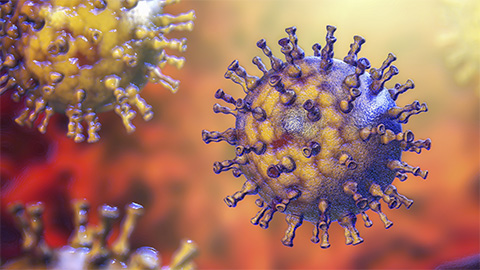08/11/2023

A client reports having Ramsay Hunt syndrome (RHS)—a version of shingles that affects the facial nerve. Her massage therapist can’t find any useful information to help guide their decisions. But they were able to establish that it isn’t contagious, so they pulled on their gloves and got to work.
Listen to this episode of I Have a Client Who . . . with host Ruth Werner to find out what happened, and why you might be seeing more about massage and RHS soon.
Resources:
Pocket Pathology: https://www.abmp.com/abmp-pocket-pathology-app
Crouch, A.E. et al. (2023) ‘Ramsay Hunt Syndrome’, in StatPearls. Treasure Island (FL): StatPearls Publishing. Available at: http://www.ncbi.nlm.nih.gov/books/NBK557409/ (Accessed: 18 July 2023).
Facial Synkinesis | Otolaryngology | Loyola Medicine (no date). Available at: https://www.loyolamedicine.org/find-a-condition-or-service/otolaryngology-ent/otolaryngology-conditions/facial-synkinesis (Accessed: 18 July 2023).
https://www.facebook.com/verywell (no date) The Geniculate Ganglion: Taste, Tears, and Facial Expression, Verywell Health. Available at: https://www.verywellhealth.com/geniculate-ganglion-4802365 (Accessed: 18 July 2023).
Massage Therapy Foundation Case Report Hub: https://massagetherapyfoundation.org/education/case-report-hub/


[music]
0:00:02.0 Ruth Werner: Hello, I have a client who listeners, Ruth Werner here and I'm so excited to let you know that my library of online self-paced continuing education courses has just expanded. I now have a two hour ethics course called, A Doctor's Note is not Good Enough and What is Better. This NCBTMB approved course goes into why a doctor's permission or approval or even a prescription doesn't provide the legal or safety protection you might think it does. Then we look at how to start useful conversations with healthcare providers that will actually get us to safe and effective massage for our clients with complex conditions. Visit my website at ruthwerner.com for more information and to register for A Doctor's Note is not Good Enough and What is Better.
[music]
0:01:00.5 RW: Hi and welcome to, I Have a Client Who, Pathology Conversations with Ruth Werner, the podcast where I will discuss your real life stories about clients with conditions that are perplexing or confusing. I'm Ruth Werner, author of a massage therapist guide to pathology and I have spent decades studying, writing about, and teaching about where massage therapy intersects with diseases and conditions that might limit our client's health. We almost always have something good to offer even with our most challenged clients, but we need to figure out a way to do that safely, effectively and within our scope of practice. And sometimes, as we have all learned, that is harder than it looks. Today's, I have a client who, story came to me through a circuitous route. A massage therapist saw this post on a Facebook group to which I don't belong and they put that person in touch with me.
0:02:00.6 RW: And then when I finally got a Zoom meeting with them, I thought it was for something completely different and the whole thing was a bit of a confusion, but happily, eventually we got it all sorted out. The post was about something called Ramsay Hunt syndrome and here's what I got from our contributor when we finally had a conversation. This practitioner lives in a little town in a very rural area. And the other massage therapists in this town don't do a lot of clinical work. So many of the more complicated situations end up with our contributor, including a client who was reported to have Ramsay Hunt syndrome, which is a variety of shingles that affects cranial nerve seven, the facial nerve. This client is a 55-year-old woman who is otherwise completely healthy.
0:02:48.0 RW: And she simply woke up with this one day and it was miserable. She was able to get on antiviral medication right away, which helped. And she also uses some essential oils and finds that catnip tea is very helpful. By the time she found our contributor as a massage therapist, she was still in a lot of pain, but most of her blisters had healed. So this practitioner went looking for any information about massage and Ramsay Hunt syndrome or RHS and shockingly didn't find anything useful. Well, I'd like to talk a little bit about this condition and then I will tell you how things went for our contributor and their client. RHS is a situation in which Varicella-Zoster virus, that's VZV, attacks extensions of the geniculate ganglion, specifically the facial nerve. Although it can look like Bell's palsy or even a stroke, RHS is in fact a type of shingles.
0:03:47.7 RW: And we've talked about shingles a few different times on, I Have a Client Who. So I won't go deeply into information about the causative virus except for to say just a few important things. Number one, it's the same virus that causes chickenpox. It's called varicella zoster virus. Number two, it is never fully expelled from the body. It goes dormant in a nerve ganglion somewhere when an infection subsides. Number three, when it reactivates, it's not a new infection. It is a resurgence of the original viral colony. And number four, it is contagious, but only to people who have no history of exposure to chickenpox or to people who are very immune compromised. Have you had chickenpox or the chickenpox vaccine? If you're old enough, maybe you even had the shingles vaccine? If so, and if you are fundamentally healthy, then you have circulating immune system cells and antibodies that will protect you from a serious new infection.
0:04:53.4 RW: RHS has a couple of other names. It is also called Herpes Zoster Oticus, which implies something about the ears, or geniculate ganglion herpes zoster, which is named for the location that this colony of virus was hiding in. That's the root of cranial nerve seven. Ramsay Hunt syndrome is pretty rare. It is less than 1% of all cases of shingles that involve the face. Unlike many two-named disorders like Charcot-Marie syndrome or Osgood-Schlatter disease, Ramsay Hunt syndrome was named after only one person, James Ramsay Hunt, who was a doctor who described it during his work in World War I. There is a classic triad of RHS symptoms, one-sided facial paralysis that looks like Bell's palsy, along with ear pain and a blistering rash that might be on the scalp, the face, the palate, the tongue.
0:05:50.4 RW: And these may appear in any order and they may last for varying amounts of time. Sometimes no rash appears at all, which makes it really difficult to get an accurate diagnosis. The inflammation of the facial nerve can also affect other nearby structures, leading to a host of confusing signs like hearing loss, tinnitus, dry mouth, a change in taste sensation, and nasal congestion. If the vestibulocochlear nerve is involved, there might also be dizziness and vertigo. Fortunately, there are some non-invasive nerve testing protocols that can help to distinguish Ramsay Hunt syndrome from Bell's palsy and stroke and Lyme disease and skull tumors and a slew of other problems. And even more fortunately, we as massage therapists, we don't have to learn these neurological tests. This is not our call. Treatment for Ramsay Hunt syndrome, if it can be started within the first few days of symptoms, involves antiviral medication, often alongside steroidal anti-inflammatories.
0:06:55.1 RW: Protecting the cornea if the person can't easily close their eye is a high priority too. And after the initial swelling goes down, there may be a long and sometimes not fully complete recovery of sensation and motor function in the face. Some patients need long-term pain medications and anti-nausea drugs for vertigo. Post-herpetic neuralgia, where the nerves continue to elicit pain responses even though they're no longer under attack, this is really common, especially among patients older than 50. Another complication, in about 30% of people who recover from Ramsay Hunt syndrome is a condition called synkinesis. And this is what happens when motor and sensory neurons heal with unexpected new connections, so a person may develop weird motor responses. Their mouth twitches when they blink, or their nose runs when they smell something delicious.
0:07:50.3 RW: Okay, so there's a quick look at a pretty rare situation, Ramsay Hunt syndrome, a version of shingles that affects the facial nerve, but it may have other repercussions with chronic pain and much more. Now, here's what our contributor told me about their client. This woman, the client, had been diagnosed with Ramsay Hunt syndrome three weeks before their appointment, which was a last-minute, 30-minute-can-you-squeeze-me-in kind of session. Fortunately, for reasons I'll share in a bit, our contributor got a very detailed intake form before they began their work together. The client's symptoms had a sudden onset, and she could not attribute it to any specific stressor. She saw her medical doctor right away, who prescribed an antiviral medication, but she did not report using steroids to her massage therapist.
0:08:41.3 RW: Our contributor observed that this client appeared to be the kind of person who's nervous when she isn't in control of her situation in general. Also her shoulders were riding high up under her ears, she was stooped over in a protective posture, and her right shoulder, quote, "felt like a cement block." That's the side that was affected. The massage therapist saw one scabbed-over blister on the client's face, otherwise the rash appeared to be fully healed, but facial paralysis was still a problem along with severe pain, which of course had repercussions in her neck and her shoulders and beyond. This massage therapist was not 100% sure what to do, but having ruled out the risk of catching a new infection because of their history with varicella zoster virus, the therapist decided to put on gloves and move forward, focusing mainly on the client's neck and shoulders during this one short session.
0:09:36.8 RW: They said, "I did a lot of work around her temporalis, the top of her head, her scalenes, her rhomboids, and her traps." Then they tried something that might not have worked. The client had been complaining that her face felt hot all the time, and she felt that the heat of the summer was making things much worse for her. So the massage therapist put a towel soaked in cold water over her face. And the client loved it. Since then, we learn, the client has taken to keeping frozen bottles of water, which she rolls over her face and neck several times every day. Our contributor hasn't had another session with the client yet, but they saw her recently, two weeks after that first short session, and almost didn't recognize her. Her shoulders are down where they belong. Her face isn't distorted. She says she's almost completely out of pain.
0:10:29.6 RW: And they have another appointment scheduled for next week. Now this is where the importance of getting a thorough client history comes in. Our contributor was frustrated that they couldn't find any reliable sources of information about safety or appropriate accommodations for massage if a client has RHS. And that's not surprising. It's not common, so anyone would have to just make their best guesses. But our contributor was especially wary of doing anything that might exacerbate the pain or maybe even trigger another onset of the rash. I appreciate that concern, since I think it's generally best to be extra conservative as we're getting to know a new client with an unknown situation. But the remarkable response of the client to the treatment and an ongoing chance to work together and track progress, well, this makes this whole relationship an excellent opportunity to write a case report.
0:11:26.7 RW: Gosh, if only they had collected good baseline information at the beginning, like pain levels and client's goals before they began. Well, they did. Because this massage therapist uses a thorough intake form, and that information is already collected. And with the client's informed consent, this massage therapist is now in a position to write and even publish a paper that could benefit the whole profession. I pointed them toward the Massage Therapy Foundation Case Report Hub, which I will link in our show notes, because it is a one-stop shop for anyone who wants to learn how to write a case report. I really hope that this therapist experience will be documented in a way that gets into our research base to help future massage therapists with clients who might have shingles, in general, and Ramsay Hunt syndrome in particular.
0:12:22.0 RW: Hey everybody, thanks for listening to, I Have a Client Who, Pathology Conversations with Ruth Werner. Remember, you can send me your, I Have a Client Who, stories to ihaveaclientwho@abmp.com. That's I Have a Client Who, all one word, all lowercase, @abmp.com. I can't wait to see what you send me, and I'll see you next time.





